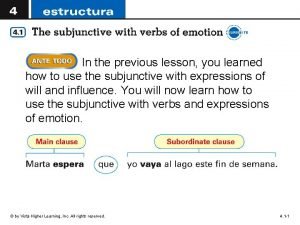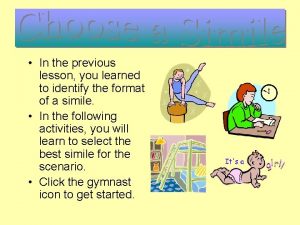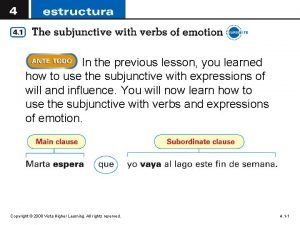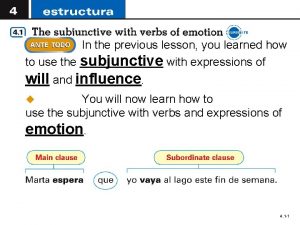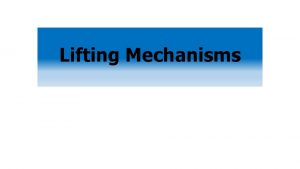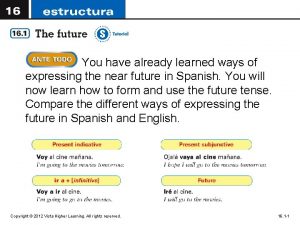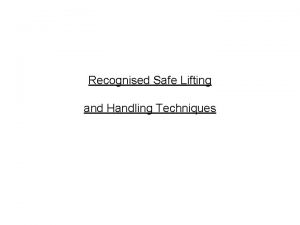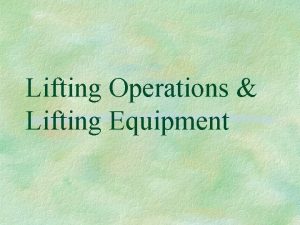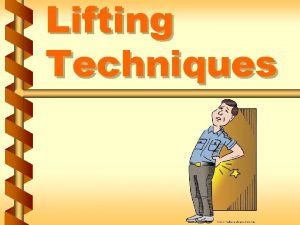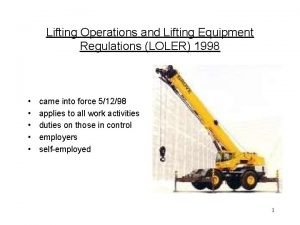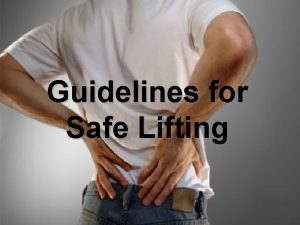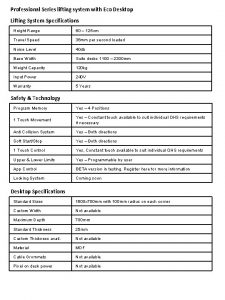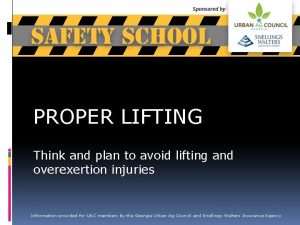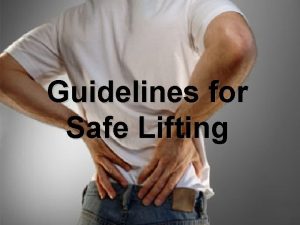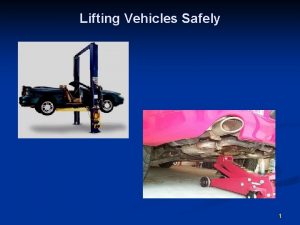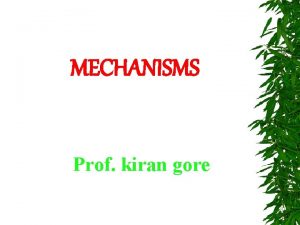Lifting Mechanisms Introduction In previous Unit you learned






























- Slides: 30

Lifting Mechanisms

Introduction • In previous Unit you learned about object manipulators which are used to obtain and control game objects. In many situations, competition robots are also required to elevate and/or reorient these game objects. This unit will discuss several types of lifting mechanisms that can be used successfully in competition robotics.

Degrees of Freedom • A degree of freedom refers to a something’s ability to move in a single independent direction of motion. To be able to move in multiple directions means to have multiple degrees of freedom. Moving up & down is one degree of freedom, moving right & left is another; something that can move up/down and left/right has TWO degrees of freedom. In the context of competition robotics, three basic degrees of freedom will be discussed.

• The first type of degree of freedom is one in which the robot’s arm can rotate about an axis parallel to the arm. This degree of freedom is found in the human wrist. One can imagine someone holding a pencil in his or her fist so it is parallel to the floor (horizontal). Now this same person twists his or her wrist such that the pencil is pointed straight up at the ceiling (vertical). This “twisting” is one degree of freedom.

• The second type of degree of freedom is linear movement. In this case, a component on a robot can slide in and out (or up and down, or left and right). An elevator represents this linear degree of freedom (moving up and down), as does a common desk drawer (moving in and out).

• The third type of degree of freedom is one in which there is rotation about an axis perpendicular to an arm. The human elbow is an example of a joint with this degree of freedom. The arm-mass systems discussed in Competition robots typically only Unit 7 and Unit 8 are require a few degrees of freedom, also examples of this since they don’t need to be as degree of freedom. versatile or dexterous as a human arm. Best practices for competition robot lifting mechanism design will be discussed in more detail in this unit.

Rotating Joints • The most frequently used lifting mechanism in competition robotics is a rotating joint. The example shows a 2 jointed arm, which includes a shoulder joint and a wrist joint (note that joints on a robot arm are often named similarly to a human arm). These joints are constructed by locking part of the robot structure onto part of a motion system. In the above case, the shoulder joint includes an arm locked to the gears of the shoulder gearbox – as these gears turn, the arm turns as well. Similarly, the claw is locked to the gears of the gearbox attached to the end of the arm. One might notice in the example that the shoulder joint has a much higher gear reduction than the wrist joint. This is done because of motor loading. The shoulder joint needs to lift the weight of the arm, the weight of the wrist joint, the weight of the claw, and whatever object the claw has picked up. The wrist joint only needs to lift the weight of the claw and the object it has grabbed. The shoulder joint also needs to lift this weight with a much longer lever arm than the wrist joint, so it is under significantly more torque. Each joint is designed to handle the loads which will be applied to it. These concepts were discussed in previous units.

• An example of a double reduction rotation joint is seen below. This joint has two stages of 12: 60 gear reductions. The second stage is attached directly attached to the robot arm. The second stage also has two of the same gear reduction running in parallel; this means that the load is divided evenly over these two sets of gears. By reducing the load on individual components, the joint is less likely to have a failure (broken gear, etc). A SHOCK LOAD is an instantaneous spike of loading on a mechanical system. Imagine someone grabs onto the arm of a robot and pushes down on it as hard as they can in a jerking motion. This would apply a shock load to the arm gearbox. It is always a good idea to design robot joints robustly enough to withstand these shock loads. Running multiple parallel gear reductions will spread shock loads and prevent damage. The first stage of gear reduction does NOT utilize parallel reductions; it has only one set of meshing gears. This is because the impact of a shock-load is lowest at the part of the gearbox closest to the motor. Typically gear stages closest to the motor do not need to be as robust as stages further into the gearbox.

• Joint Loading: • In order to effectively utilize a motor, one needs to adjust the load applied to its motor such that it runs within acceptable parameters. Methods for using mechanical advantage and gear reduction to optimize motor loading were discussed in previous units. • If there is some force applied at the end of the robot arm (as discussed in Unit 7) it will apply a torque on the joint equal to the magnitude of the force multiplied by its distance from the joint. This applied force is partially caused by the weight of the arm itself, as well as any forces the arm will encounter during operation (weight of objects it is lifting, etc. ) • When choosing the appropriate gear reduction for an arm, it is a good idea to add a Factor of Safety to these forces to ensure the joint can handle any unanticipated loads it encounters. A factor of safety, also known as a margin of safety, describes the amount of overage the system can handle. Basically if the robot needs to be able to lift with a force of 10 N, one might design the robot to handle 12 N. This would be a factor of safety of 1. 2 (10 * 1. 2 = 12). This factor of safety will take care of any unexpected loads the arm encounters. It is always a good practice to take the unexpected into account when designing.

• Joint Speed: • Often it is important for a joint to move as quickly as possible; however, this is not always practical. Designing a joint to be too fast may make it uncontrollable without advanced software. • There are two approaches to choosing the gear reduction required for a rotating joint. Either method will work for any rotating joint design. If the amount of load the joint can lift is critical, designers should use Approach 1. If the speed of the joint is more important than what will be lifted, designers should use Approach 2.

• Approach 1 – Start with Loading: • Step 1 – Determine the applied load on the end of the arm, and the length of the arm. • Step 2 – Determine the maximum load which can be applied on the motor. (Refer to Unit speed, power, torque, and DC motors). • Step 3 – Determine the required gear reduction which results in the desired motor loading. • Step 4 – Calculate how fast the arm will be rotating with this gear reduction. • Step 5 – Determine if this is a “good” speed. • Step 6 a – If it is “good”, build it. • Step 6 b – If it is too fast, determine how fast the joint needs to move, and then calculate the gearing required for this speed (it will be slower than the previously calculated speed). Then build it. • Step 6 c – If it is too slow, additional power to the system so it can handle this load at a faster speed (add additional motors to this joint). Then recalculate. • Step 6 d – If the end result does not meet expectations, the constraints of the system need to be reevaluated and a redesign should be considered. • Also note: reducing the length of the arm attached to the joint will reduce the amount of load on the motor (as discussed in speed, power, torque, and Dc motors). This is one of the options a designer can choose if the output result does not meet his or her expectations. • Both of the above approaches will work well for designing a rotating joint. Each process requires iteration to be successful, and designers may find themselves doing and redoing calculations in an effort to find a design which works best for their given situation.

• Approach 2 – Start with Speed: • Step 1 - Determine the desired speed of the joint, i. e. 90 degrees per second. • Step 2 – Determine the required gear reduction to achieve this desired speed. (Refer to Unit 8). • Step 3 – Determine the maximum load which can be applied on the motor. (Refer to Unit 7). • Step 4 – Determine the maximum load which can be lifted by the arm based on the gear reduction from step 2 and the maximum motor load from step 3. • Step 5 – Determine if this maximum lifting load is acceptable based on what the load on the joint will likely be (including safety factor). • Step 6 a – If the load is “good”, build it. • Step 6 b – If the load is too low, and the designer is willing to reduce the speed of the joint to accommodate this load, he or she should redesign based on Approach 1, above. • Step 6 c – If the load is too low, and the designer is NOT willing to reduce the speed of the joint, he or she should additional power to the joint and then recalculate.

• Another lifting mechanism commonly used in competition robotics is a linear elevator. The VEX Robotics Design System has many different ways to create rotational mechanisms and lowfriction rotating joints but has only a few methods for low-friction linear motion. As a result, this type of mechanism is less common than a rotating joint on competition robots; however, it does have some advantages. • As seen in the example below, as the rotating joint raises upwards the robot’s claw will swing in an arc about the point of rotation. This means the distance between the claw and the drive base varies depending on the height the claw is at. If a driver is trying to score in goals of different heights, the driver must position the robot the correct distance away based on the height of the goal. Elevators

• As seen in the example below, as the rotating joint raises upwards the robot’s claw will swing in an arc about the point of rotation. This means the distance between the claw and the drive base varies depending on the height the claw is at. If a driver is trying to score in goals of different heights, the driver must position the robot the correct distance away based on the height of the goal.

• A claw mounted on a linear elevator is always a consistent distance from the drivebase, so regardless of the goal height, the driver will need to move the robot to the same distance from the goal. • Another difference between an elevator and rotating joint is the way the object changes orientation. In a rotating joint, as the joint lifts the arm changes orientation. A linear elevator does not change orientation as it elevates. In the above example, as the rotating joint lifts the cup, it spills it! The elevator lifts the cup straight up without any spilling.

• Elevator Actuation & Loading: • Actuation of a linear elevator is a little different than a rotating joint. Unlike a rotating joint, an elevator somehow must convert the rotary motion of a motor into the linear motion required to drive the elevator. There are several ways this is commonly accomplished. In the above example a rack and pinion mechanism is used to drive the elevator. The pinion gear spins at some speed with an applied torque. This torque then applies a linear force at the gear’s pitch circle, which drives the mechanism.

The above image shows how chain and sprockets can be used to drive a linear elevator. The torque on the driving sprocket spins the chain. The chain is attached to the linear elevator, and exerts a linear force to drive the mechanism In the above example, a winch is used to drive a linear elevator. A motor applies torque to the winch which provides a linear force along a rope, which then drives the mechanism.

• Multiple Stage Elevators: • Single stage elevators are able to lift up only one extension of their length. That is, if the elevator is one meter tall, it will be able to lift a claw from the bottom to the top, a total of one meter. However, multiple stage mechanisms are also possible. By stacking multiple linear elevators together, one can create a mechanism which will reach up much higher than their own height.

Linkages • Linkages are designed to convert some input motion into a different output motion. A linkage typically consists of a series of rigid bodies called links, connected together by freely rotating joints. Typically, one link is fixed and cannot move, and one link is driven in some input motion. Linkages are a fundamental part of machine design because of their ability to create such a wide variety of output motions and their ability to alter the path, velocity, and acceleration of the input. Very precise and somewhat complicated motions can be designed using a simple linkage design. Linkage motions are extremely repeatable. • Linkages are found in many places throughout the world. Below is an example of a simple linkage found on a pair of Vice Grips

• The link at the bottom is the input link which is driven, and the link at the top is the fixed link. The second picture shows the linkage at the other end of its motion. This is a linkage with four links, each link has two joints. This is one of the most common types of linkage systems.

Four Bar Linkages: • One of the simplest and most common linkage types is the four bar linkage. This is a linkage system which can provide a wide variety of motions depending on its configuration. By varying the length of each link, one can greatly change the output motion. The most basic type of 4 -bar linkage is one where the links are equal length and parallel to each other, as seen below: In this particular setup, as the linkage travels through its motion the output link will remain parallel to the fixed link. As such, the claw remains in a consistent configuration. This would be useful for an application where the object manipulator must remain in the same orientation relative to the ground. However, not all 4 -bars take this configuration.

In this example of a four-bar linkage, the output motion is very different from the previous example! By tweaking the lengths of the different links, a designer can create many different designs. Using the VEX Robotics Design System it is easy to experiment with linkages to test their different motions.

• The above linkage prototypes can be created with only a few VEX metal pieces, and a few screws.

Design of Lifting Mechanisms • This unit described a number of different lifting mechanisms, but which one will work best on a given robot? • There a few key considerations, discussed below, which designers should take into account when designing a lifting mechanism. • Elevation Required: • The first and most important consideration a designer needs to take into account is the elevation required. At what height does the robot pick up the object? At what height does the robot need to lift the object? Are there multiple heights the object will need to be scored at? What mechanism will accomplish these changes in elevation? • Object Orientation: • Another important consideration for a designer is the change of orientation the object will go through, if any. What orientation(s) will the objects be in when picked up? What orientation(s) will the object be in when scored? Are these orientations different at different elevations? Often, the lifting mechanism can be used to accomplish these orientation changes. Some lifting mechanisms will be better suited to an application than others due to required orientation changes. For instance, if the object needs to stay in the same orientation from when it is picked up until it is scored, a rotating joint may not be as good a choice as a linear elevator.

• Starting Configuration & Other Size Limitations: • VEX Robotics Competition robots must start each match within a limited size, as described in the Game Rules released each year. This starting size may restrict which lifting mechanisms can be used. For instance, a single jointed arm which starts within an 18” x 18” box cannot reach up four feet – though a multiple jointed arm might be able to do it. There are often other size limitations involved in the creation of a competition robot. What if there is a bar on the field that the robot must drive under? In this situation a designer may choose to design so his or her robot’s lifting mechanism can fold down under the height of this bar. Size limitations play a large role in the design of lifting mechanisms, especially when combined with elevation requirements as discussed above. It is easy to make a robot reach up four feet; it is more difficult to make a robot start in an 18” cube and then reach up four feet. • Some lifting mechanisms may take up more space than others. If the robot has a large hopper-style object manipulator, and it takes up almost all of the space in the robot’s starting configuration, the designer will need to find a lifting mechanism that will package into the space available. Some lifting mechanisms may “fit” better than others.

• Complexity: • In some situations, multiple lifting mechanisms may all work. However, these mechanisms can vary greatly in complexity. It is usually a good idea to choose the simplest mechanism possible which accomplishes the design goals. Sometimes, it is even beneficial to make tradeoffs and reduce the design goals. For example, if a simple mechanism is “almost good enough” to achieve the design goals, and if fully accomplishing the goals would require a VERY complex mechanism, it is probably better to choose the simple mechanism. Simple mechanisms have fewer moving parts, are more robust, and are less likely to fail; in these ways, they are usually better. • Motors Required: • Competition robots are limited in the number of motors and other actuators that they are allowed to use. Designers should be cognizant of how many motors are required for each lifting mechanism option. A 2 jointed arm requires two motors, one for each joint, whereas a single jointed arm only requires one motor. In this case, the designer could still use two motors (as described in Units 7 & 8) and the mechanism would be able to handle its load twice as fast!

Passive Assistance • One “expert trick” used by many competition robotics teams is based on the concept of passive assistance. Passive assistance is when a designer adds something to the lifting mechanism to assist the actuator in lifting the load. Usually these take the form of counterbalances or springs. If the lifting mechanism is trying to lift a claw with a 1 Newton weight in it, and the designer adds in 1 N worth of spring force, the motor will only need to lift the weight of the claw! Using passive assistance can GREATLY reduce the load on the motors and allow for much faster mechanisms that lift much greater load. In certain situations, it may even be beneficial to use so much passive assistance that the motor must work to pull the lifting mechanism down. • Consider a robot that is lifting a ball which exerts a force on the end of an arm of 4 Newtons (for this example, one can assume the arm and claw weigh nothing). The designer could add 2 Newtons of passive assistance springs to the arm. This means when the arm is lifting up, the motor is exerting 2 Newtons and the spring is adding 2 Newtons to lift the 4 Newton ball. After dropping the ball into a goal, the motor would then need to fight against the springs to lower the arm, and would exert 2 Newtons of force. • The most common kinds of passive assistance used in the construction of VEX Robots are elastic surgical tubing and rubber bands. These can be stretched in such a way that they contribute to the upward motion of a lifting mechanism.

There are tradeoffs involved in using passive assistance, but clever designers can use it to reduce the load on their motors, and make their lifting mechanisms much quicker and more robust.

Design Activity • Lifting Mechanism Construction • Using the lessons learned in this unit, students should follow a design process similar to the one described in Unit 1 to determine a lifting mechanism for their competition robot. Students should brainstorm multiple solutions and record the entire process in their engineering notebooks. Students should choose one concept and design it in Autodesk Inventor and/or build it using VEX Components. • When designing your Lifting mechanism, ask yourself the following questions to get started: • What do you want your lifting mechanism construction to achieve? • Will a simple Elevator lift achieve the Design objective or would it be better to use a 4 Bar? • Will you need to use a Rotating Joint? • Do you need to use Linkages to transfer the motion? • How many motors are you going to have to use? • Can you use Passive Assistance? • • To be able to complete this activity you should have a basic understanding of the Autodesk Inventor user interface, navigation, and know how to Create Parts and work with Assemblies.

QUIZ • Answer the following questions 1. Explain how the degrees of freedom will allow you to design a robot that is able to transfer motion as it manipulates game objects. 2. Explain how a linkage system allows a robot to score on a high goal in a game situation. 3. Explain how passive assistance can provide your robot with a mechanical advantage.
 On the previous lesson
On the previous lesson In the previous lesson
In the previous lesson In the previous lesson you have learned that
In the previous lesson you have learned that Contaminar subjunctive
Contaminar subjunctive Lifting tackles & appliances
Lifting tackles & appliances Different lifting mechanisms
Different lifting mechanisms Value received and value parted with
Value received and value parted with In this unit you learned to
In this unit you learned to In this unit you learned to talk about home maintenance
In this unit you learned to talk about home maintenance You must unlearn what you have learned
You must unlearn what you have learned Types of lifting and moving patients
Types of lifting and moving patients The lorax story is often called a cautionary tale
The lorax story is often called a cautionary tale Cause and effect keywords
Cause and effect keywords I have already learned
I have already learned Habit as a modifier of human act
Habit as a modifier of human act What have you learned lately
What have you learned lately Now that you have learned about this concept
Now that you have learned about this concept Unit 10, unit 10 review tests, unit 10 general test
Unit 10, unit 10 review tests, unit 10 general test Do you love rain
Do you love rain You are what you eat do you agree or disagree
You are what you eat do you agree or disagree If you think you can you can poem
If you think you can you can poem Tell me what you eat and i shall tell you what you are
Tell me what you eat and i shall tell you what you are I will follow you wherever you go goes will go
I will follow you wherever you go goes will go Orthodox lifting in nursing
Orthodox lifting in nursing Ergonomic lifting techniques
Ergonomic lifting techniques Kinetic lifting meaning
Kinetic lifting meaning A pully
A pully Spinal precautions blt
Spinal precautions blt Frontal lifting
Frontal lifting Frontal lifting
Frontal lifting Knee replacement
Knee replacement
